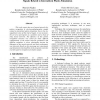Free Online Productivity Tools
i2Speak
i2Symbol
i2OCR
iTex2Img
iWeb2Print
iWeb2Shot
i2Type
iPdf2Split
iPdf2Merge
i2Bopomofo
i2Arabic
i2Style
i2Image
i2PDF
iLatex2Rtf
Sci2ools
SBRN
2002
IEEE
2002
IEEE
Using a Chain of LVQ Neural Networks for Pattern Recognition of EEG Signals Related to Intermittent Photic-Stimulation
This work reports the use of neural networks for pattern recognition in electroencephalographic signals related to intermittent photic-stimulation. Due to the low signal/noise ratio of this kind of signal, it was necessary the use of a spectrogram as a predictor and a chain of LVQ neural networks. The efficiency of this pattern recognition structure was tested for many different configurations of the neural networks parameters and different volunteers. A direct relationship between the dimension of the neural networks and their performance was observed. Results so far encourage new experiments and demonstrate the feasibility of the proposed system for real-time pattern recognition of complex signals.
| Added | 15 Jul 2010 |
| Updated | 15 Jul 2010 |
| Type | Conference |
| Year | 2002 |
| Where | SBRN |
| Authors | Mauricio Kugler, Heitor Silvério Lopes |
Comments (0)

